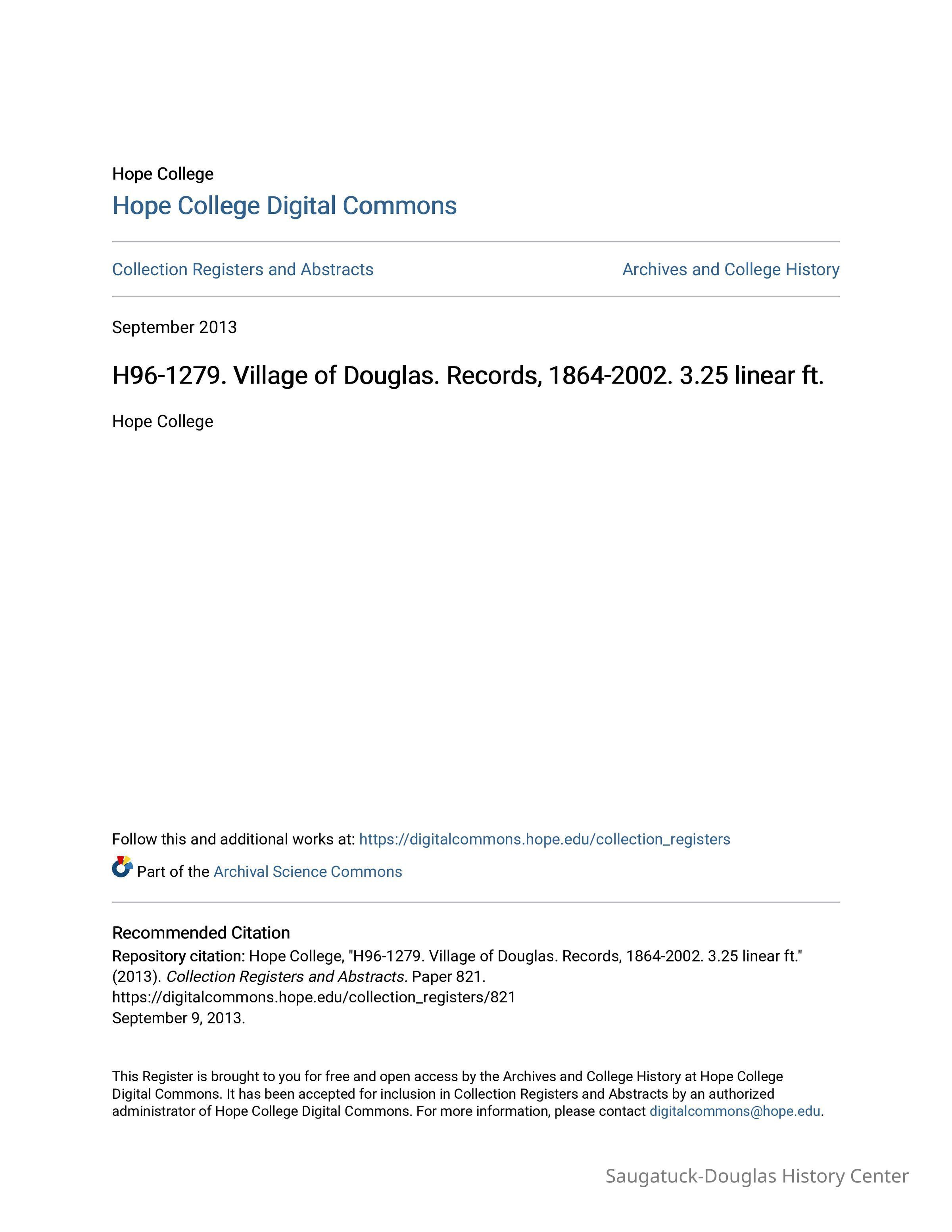Douglas Records, 1864-2002

This collection consists of materials relating to the history of the Village of Douglas in Allegan County, Michigan. Included are newspaper clippings, ordinances, council proceedings (minutes), registration lists for elections, a history paper by Larry J. Wagenaar, property tax assessment records, and records of the village treasurer and clerk. Also includes a copy of a map of the village in 1864 and an oversized street-layout map from 1961.
Property records and tax assessmentsDouglas, government
Processed by Michael Douma, July 2003
Box 1
Map, Dudleyville/Douglas, 1864 Newspaper Clippings Holland Sentinel, 1992-2002 The Commercial Record, 1954, 1964, 1967 Paper, “Douglas: A Unique History of a Community,” Larry J. Wagenaar, 1987
Box 2
Bonds and Oaths, 1929-1938 Council Proceedings, 1871-1895, 1938-1947 (2 volumes)
Box 3
Council Proceedings, 1948-1963, 1965-1972 (3 volumes)
Box 4
Receipts and Expenditures, 1936-1952 Treasurer’s Records, 1896-1924 Ordinances, 1924-1968
Box 5
Clerk’s Register of Warrants, 1895-1919 Clerk’s Account Book, 1961-1969
Box 6
Property Tax Assessments, 1892, 1894, 1896, 1897, 1898 (6 volumes)
Box 7
Property Tax Assessments, 1899, 1900, 1906, 1907 (5 volumes)
Box 8
Registration for Election, 1902-1930, 1934-1946 (2 volumes) Oversized Map of Douglas, 1961
Joint Archives of Holland
The land on which Douglas lies was previously inhabited by Pottawatomie Indians. In 1851, Jonathan Wade built the first house in the area of what became the failed city of Singapore. Wade, however, named his town Dudleyville, after his brother from Canada. Other early white settlers included William Scoville and Robert McDonald. Of more influence was William Dutcher, who purchased land in the area and officially platted it, naming it Dutchville. Later, Wade sold a portion of land to Dutcher in 1861 and the city was replatted and re-named again, apparently at the suggestion of other settlers, who had since moved there. Eventually, by decision at a town meeting, the town was named after the American Statesman, Stephen A. Douglas. It also appears, however, that Wade’s nephew, Col. Fred May, who came from Douglas on the Isle of Man, also suggested the same name. A debate about the origin of the village’s name continues, but the most likely explanation for the name involved a combination of these two sources above. The town was incorporated as a village in 1870. The area was home to many sawmills and the related lumber industry which was integral in providing for the rebuilding of Chicago after the Great Fire of 1871. The lumber industry worked itself out of a job and the area turned over to fruit production. Peaches from the area were called “Michigan Gold” and were sent by steamship to the Chicago market. A maritime industry thrived in the harbor shared with Saugatuck. A resort, tourist, and “cottage” culture emerged in the 1880s and took a propitious turn in 1910 when a group of Chicago artists established the Summer School of Paintings on Ox-Bow Lagoon, and when a huge dance hall, called the Big Pavilion, was built on the waterfront. Dreams of a booming city at the mouth of the Kalamazoo River faded way as the population stagnated then decreased, hitting a low of 305 in 1920. The village has grown steadily and has all but merged with Saugatuck. The issue of forming a conjoined city with neighboring Saugatuck has been an issue for most of the history of the village. Douglas remains a cultural and art center with an historic downtown and an active historical society.
04/18/2022
11/18/2023
